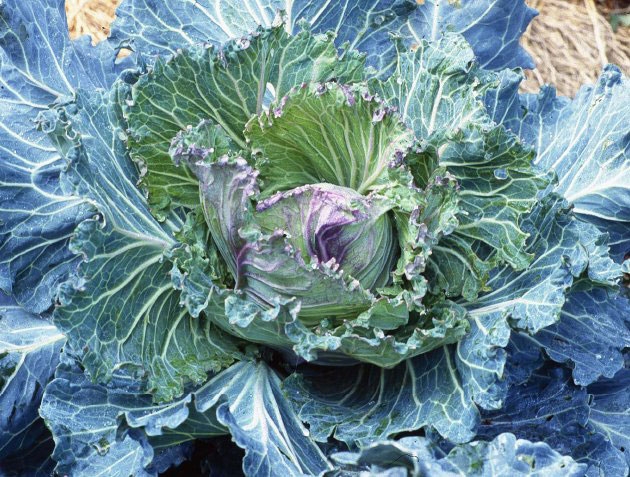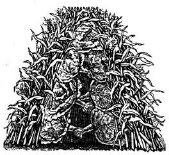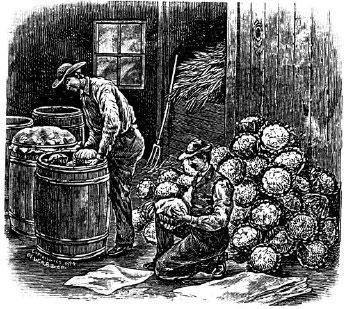Heirloom Cabbage Varieties and Other Members of the Brassica Family
By William Woys Weaver
Heirloom Vegetable Gardening by William Woys Weaver is the culmination of some thirty years of first-hand knowledge of growing, tasting and cooking with heirloom vegetables. A staunch supporter of organic gardening techniques, Will Weaver has grown every one of the featured 280 varieties of vegetables, and he walks the novice gardener through the basics of planting, growing and seed saving. Sprinkled throughout the gardening advice are old-fashioned recipes — such as Parsnip Cake, Artichoke Pie and Pepper Wine — that highlight the flavor of these vegetables. The following excerpt on heirloom cabbage varieties was taken from chapter 10, "Cabbages."
Buy the brand new e-book of Weaver's gardening classic in the MOTHER EARTH NEWS store: Heirloom Vegetable Gardening.
A Brief History of Heirloom Cabbage Varieties and Other Brassicas
I doubt that the average grocery store shopper is aware that kohlrabies, broccoli, cauliflower, Brussels sprouts, kale, and heading cabbages are all variations of the same plant. Since these vegetables often come to season at different times and are often displayed in separate areas of our markets, it is only natural not to think of them in this unified fashion. Yet the gardener must confront this reality, for when it comes to saving seed, this kinship is crucial.
Many of the vegetables in this book have distinguished genealogies, but none are more complicated than those of the brassicas, owing to the crossing of various forms and the ease with which these plants can be altered through selective cultivation. They are also extremely rich in many of the basic nutrients required by humans; thus their place in the historical kitchen garden was established long, long ago. Unfortunately, since they are biennial, all of the brassicas present special difficulties for the gardener who wants to preserve heirloom varieties. At the outset, I must confess that this problem presented me with many knotty choices, for while there are hundreds of heirloom varieties to choose from, not many of them are as simple to grow as lettuce.
While glancing through the 1867 seed catalog of the Baltimore seedsmen E. Whitman & Sons, I noticed that they pragmatically advised such old standby varieties of cabbage as Early Wakefield, Early York, Ox Heart (a French variety), and Winnigstädt. I have decided to follow this same course at the expense of the more exotic heirlooms that are now surfacing among seed savers. The same may be said of the kales and cauliflowers, and all the other brassicas listed in this section. However, I have tried to build into my selections a certain degree of variety; enough, I believe, that after a few seasons the beginning gardener will know which types are most practical for the garden and which are not. Need I remind my readers that with cabbages, soil is everything, and fertility is all the rest? Good cabbage land must be well manured. I should point out that all the members of the genus Brassica and the species oleracea trace their genetic origin to northwestern Europe, specifically to the coastal region extending from western France to Holland and including the southern coast of England. This family of vegetables was first cultivated by the ancient Celts, who also gave us our basic cabbage vocabulary. The Celts had several words for cabbages, which in itself implies a high level of cultivation. The Celtic word kol became Kohl in German; kal became kale in English. The Celtic term bresic became brassica in Latin, and kap, a term for heading cabbages, became Kappes in German and cabbage in English.
The Romans knew cabbages well and cultivated a great many varieties. They differentiated three basic types: a crinkled or curly-leafed type equivalent to curly-leafed kale; a smooth-leafed sort similar to open-headed cabbages like Green Glaze; and wild cabbage with small round leaves gathered as a colewort or collard. The Romans also grew cauliflower, which they called cyma, and tall cabbages with large stems like the couve tronchuda or Portugal Cabbage. Descriptions of the old varieties survive in Roman agricultural literature, but without the aid of pictures (which do not survive), it is not possible to form a definite impression about their specific appearance or how they might be related to one another. This is important when discussing heirloom cabbages, because many of them may be much older than documentation suggests. In any case, to me some of the most interesting cabbages from a culinary standpoint are also historically some of the oldest. If I had my choice, I would recommend the English variety known as Vanack. It is an old Sussex and Hampshire cabbage that was preserved in the gardens of the countess of Bridgewater at Ashbridge, Hertfordshire, and in the gardens of the earl of Egremont at Petworth since the middle of the eighteenth century. But alas, seed is not generally available, and so it is with many of the most fascinating cabbages.
Commonly Grown Heirloom Cabbage Varieties
The most commonly grown heirloom members of the cabbage family may be divided into eight cultivated forms, classified in the following manner, according to Hortus Third:
- Cabbages that form heads: Brassica oleracea var. capitata L. American truck farmers usually divide this into the Wakefield group, cabbages with pointed heads, and the Copenhagen group, cabbages that form heads in the shape of round balls. Actually, there is also a third group which includes the drumheads, cabbages with broad, flat heads. One of the best known of the early American varieties in this last group was Large Bergen, also called Great American.
- Savoy cabbages, characterized by blistered or puckered leaves: Brassica oleracea var. bullata. Savoys come in a variety of head shapes, from very loose, leafy heads resembling kale to monstrous drumheads. For flavor, I think the best savoys are the smallest varieties. Savoys are also extremely hardy, more so than many of the other heading cabbages.
- Italian broccoli, asparagus broccoli, sprouting broccoli, and all forms of broccoli that do not form solid heads: Brassica oleracea var. italica Plenck. These are easy to grow, but sensitive to drought and cold weather.
- Portugal cabbages or couve tronchuda, cabbages with thick stems used like celery: Brassica oleracea var. tronchuda. There are many subvarieties. In the St. Gall cloister garden (A.D. 820) in Switzerland, a bed was set aside for cabbages (caulas) of a sort similar to the tronchuda group.
- Kohlrabi: Brassica oleracea var. gongylodes L.
- Broccoli and cauliflowers: Brassica oleracea var. botrytis L.
- Brussels sprouts: Brassica oleracea var. gemmifera. This group is the most recent historically, for it did not appear until 1785.
- Cow cabbages, tree kales, collards, and rosette-headed kales: Brassica oleracea var. acephala. Most of the oldest forms of cabbage belong to this group
Brassica Seed Saving Advice
When purchasing seeds, be certain that the packages are clearly marked according to botanical group. There are kales and cabbages from Asia which do not belong to the oleracea species. It is important to know this when growing out plants for seed-saving purposes, and it is even better to check a reliable reference if there is any question. I have purchased seed from seed companies only to discover that the contents were not properly identified; there is no excuse for this.
Most of the heirloom varieties presently available date from the nineteenth century, one of the exceptions being Early York, an English variety introduced from Flanders in the early eighteenth century. A strain called Large York was once grown extensively around Philadelphia; its equivalent among the Pennsylvania Dutch was Large Early Schweinfurt, a Palatine variety introduced in the eighteenth century, but not available commercially in this country until almost a hundred years later. Even Chinese cabbages have been known in the West for a much greater length of time than many gardeners would suppose. The chou chinense (pe-tsai), a member of the genus Brassica, but of the species rapa, and several Chinese mustards were introduced into Europe in 1836. According to an article in Le Bon Jardinier (1839), the seed was brought from China by missionaries. Otherwise, a large portion of the surviving heirlooms are improved strains rather than facsimiles of the original introductions. The difficulty of overwintering cabbages of all sorts for seed-saving purposes has greatly limited the availability of many varieties among seed savers. More reliable is the seed from the small seed houses listed at the back of this book, since several of them specialize in heirloom cabbages. They are able to grow many different varieties under contract, whereas the home gardener must rely on one or two varieties brought to flower at different times—hand pollination is simply out of the question. Serious seed savers might want to refer to J. M. Lupton’s Cabbage and Cauliflower for Profit, first published in 1894, as a useful guide to raising heirloom American cabbages. His article “Development of the Cabbage” in the American Garden (1890, 289–91) is particularly useful for understanding how cabbages were evaluated in the nineteenth century and why some varieties were preserved while others were not.
Storing and Harvesting Cabbage Varieties
Seed saving is compounded by the fact that cabbages are out-pollinating, which means that pollen must be transferred from one plant to another rather than from flower to flower on the same plant. Therefore, many more plants are required to produce seed with a good genetic balance. Ten plants are an advisable minimum. There are several ways to deal with this.
First, whole plants can be dug up, potted, and stored over the winter in a cool shed, cool enough to keep them dormant but not so cold that they freeze. Or, if there is sufficient corn in the garden, save the stalks and bury the cabbages as shown in the old woodcut. The corn stalks form an insulated barrier, especially effective if the cabbages are laid in a shallow pit. Throw sod over the corn or a tarp so that raccoons cannot dig into the hill. In the spring, replant the cabbages and let them bloom for seed.
Second, there is another method that also saves a great deal of space. When harvesting the cabbages, trim them off as close to the head as possible, leaving the stem undamaged. Mark the stems of the plants that produced crops most true to type. Dig up those stems with their roots and store them in damp sand in a Styrofoam ice chest. Put the chest in a cool shed or garage where the stems will not freeze. Planted in the spring, the stems will develop sprouts and flowers. Seed can be saved from these flowers.
Lastly, cabbages can be propagated by cuttings, which eliminates the necessity of saving seed. Select the stems of the best plants and slice them into quarters from top to bottom, making certain that each piece has roots. Dip the roots in hormonal rooting compound and plant in sand in flower pots or in a cold frame. In the spring the cuttings can be planted like seedling cabbages. This process can be continued from year to year, thus perpetuating and increasing the cabbages with the best traits. This technique is especially useful where several varieties are being grown together and there is a definite need to avoid crosses. Cuttings can also be taken from woody stems by slicing across right above the leaf nodes, but this method is tricky and requires experience. Normally, roots will develop at the nodes where sprouts would form. However, if the stems are too green and soft, the cuttings may rot before they take root.
I have used all of these techniques successfully for everything except kohlrabi. I have not attempted it with kohlrabi due to the nature of its root, and frankly, it is much easier to order fresh seed so that I can concentrate on the cabbages that are rare or difficult to obtain. At some point, every gardener must decide which vegetables to perpetuate through seed-saving techniques and which to obtain from seedsmen. It is far better to grow one or two of the oleraceas well than to drown enthusiasm in a baptism of crop failures or strange-looking culinary mules.
Other brassicas treated in this book include rocket, two cresses, and radishes. In general, the seed viability for the cabbages, kales, cauliflowers, and Brussels sprouts listed in the following pages is four to five years. However, I would suggest not saving seed beyond three years. Old seed sometimes produces deformed plants, and weak plants are particularly vulnerable to insects and disease. Formerly, it was common practice among gardeners to plant two-year-old seed, as the Gardener’s Magazine (1828, 246) pointed out: “All the brassica seeds are apt to run when newly saved and early sown.” There seems to be some logic to this.


